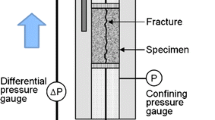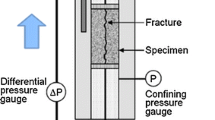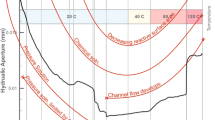Abstract
The geological formation immediately surrounding a nuclear waste disposal facility has the potential to undergo a complex set of physical and chemical processes starting from construction and continuing many years after closure. The DECOVALEX project (DEvelopment of COupled models and their VALidation against EXperiments) was established and maintained by a variety of waste management organizations, regulators and research organizations to help improve capabilities in experimental interpretation, numerical modelling and blind prediction of complex coupled systems. In the present round of DECOVALEX (D-2015), one component of Task C1 has considered the detailed experimental work of Yasuhara et al. (Appl Geochem 26:2074–2088, 2011), wherein three natural fractures in Mizunami granite are subject to variable fluid flows, mechanical confining pressure and different applied temperatures. This paper presents a synthesis of the completed work of six separate research teams, building on work considering a single synthetic fracture in novaculite. A range of approaches are presented including full geochemical reactive transport modelling and 2D and 3D high-resolution coupled thermo–hydro–mechanical–chemical (THMC) models. The work shows that reasonable fits can be obtained to the experimental data using a variety of approaches, but considerable uncertainty remains as to the relative importance of competing process sets. The work also illustrates that a good understanding of fracture topography, interaction with the granite matrix, a good understanding of the geochemistry and the associated multi-scale THMC process behaviours is a necessary pre-cursor to considering predictive models of such a system.














Similar content being viewed by others
References
Aagaard P, Helgeson HC (1982) Thermodynamic and kinetic constraints on reaction rates among minerals and aqueous solutions. I. Theoretical considerations. Am J Sci 282(3):237–285
Bethke CM, Yeakel S (2013) Reactive transport modeling guide. Aqueous Solutions, LLC, Champaign, IL. http://gwb.com/pdf/GWB9/GWBtransport.pdf
Bond A (2016) Task C1 final report. KTH Report ISBN 978-91-7595-829-3(06), ISSN 1650-86-10. http://www.decovalex.org/resources.html#reports
Bond AE, Benbow S, Wilson J, McDermott C, English M (2012) Coupled hydro-mechanical–chemical process modelling argillaceous formations for DECOVALEX-2011. Miner Mag 76(8):3131–3143
Bond AE, Brusky I, Cao T, Chittenden N, Fedors R, Feng X-T, Gwo J-P, Lang P, McDermott C, Neretnieks I, Pan PZ, Šembera J, Watanabe N, Zheng H, Yasuhara H (2016) Synthesis of coupled THMC modelling of a single novaculite fracture for DECOVALEX-2015. http://www.decovalex.org/resources.html#special-issues
BRGM (2011) Thermoddem geochemical database. Geochemist’s Workbench version ‘gwb_lv1_thermoddem_lvl1_no-org_15dec11’. http://thermoddem.brgm.fr/recherche.asp
Chittenden N, McDermott CI, Bond AE, Wilson J (2016) Bounding the uncertainty of key thermal, hydraulic, mechanical, and chemical processes during fluid flow in fractured granite. http://www.decovalex.org/resources.html#special-issues
Fetter CW (1994) Applied hydrogeology, 3rd edn. Prentice Hall, New Jersey, p 07458
JNC (2000) Regional hydrogeological study project results from 1992–1999 period, JNC technical report, JNC TN7400 2000-014 (in Japanese with English abstract)
Kolditz O, Bauer S, Bilke L, Böttcher N, Delfs JO, Fischer T, Görke UJ, Kalbacher T, Kosakowski G, McDermott CI, Park CH, Radu F, Rink K, Shao H, Shao HB, Sun F, Sun YY, Singh AK, Taron J, Walther M, Wang W, Watanabe N, Wu N, Xie M, Xu W, Zehner B (2012) OpenGeoSys: an open-source initiative for numerical simulation of thermo-hydro-mechanical/chemical (THM/C) processes in porous media. Environ Earth Sci 67(2):589–599
Lang PS, Paluszny A, Zimmerman RW (2015) Hydraulic sealing due to pressure solution contact zone growth in siliciclastic rock fractures. J Geophys Res Solid Earth 120(6):4080–4101. doi:10.1002/2015JB011968
Matthäi SK, Mezentsev AA, Pain CC, Eaton MD (2005) A high-order TVD transport method for hybrid meshes on complex geometry. Int J Numer Methods Fluids 47:1181–1187
McDermott C, Bond A, Fraser-Harris A, Chittenden N, Thatcher K (2015) Application of hybrid numerical and analytical solutions for the simulation of coupled thermal hydraulic mechanical and chemical processes during fluid flow through a fractured rock. http://www.decovalex.org/resources.html#special-issues
Neretnieks I (2014) Stress-mediated closing of fractures—impact of matrix diffusion. J Geophys Res Solid Earth 119(5):4149–4163
Palandri JL, Kharaka YK (2004) A compilation of rate parameters of mineral-water interaction kinetics for application to geochemical modelling. US Geological survey open file report 2004–1068, USA
Paluszny A, Matthäi SK, Hohmeyer M (2007) Hybrid finite element-finite volume discretization of complex geologic structures and a new simulation workflow demonstrated on fractured rocks. Geofluids 7(2):186–208
Pan PZ, Feng XT (2013) Numerical study on coupled thermo-mechanical processes in Äspö Pillar Stability Experiment. J Rock Mech Geotech Eng 5(2):136–144
Pan PZ, Feng XT, Huang XH, Cui Q, Zhou H (2009) Coupled THM processes in EDZ of crystalline rocks using an elasto-plastic cellular automaton. Environ Geol 57(6):1299–1311
Pan PZ, Feng XT, Xu DP, Shen LF, Yang J (2011) Modelling fluid flow through a single fracture with different contacts using cellular automata. Comput Geotech 38(8):959–969
Pan PZ, Feng XT, Zheng H, Bond AE (2016) An approach to simulate the THMC process in single Novaculite fracture using an EPCA. http://www.decovalex.org/resources.html#special-issues
Poon C, Sayles R, Jones T (1992) Surface measurement and fractal characterization of naturally fractured rocks. J Phys D: Appl 25:1269
Quintessa (2013) QPAC: Quintessa’s general-purpose modelling software. QRS-QPAC-11, June 2013. www.quintessa.org/qpac
Soler JM, Landa J, Havlova V, Tachi Y, Ebina T, Sardini P, Siitari-Kauppi M, Eikenberg J, Martin AJ (2015) Comparative modeling of an in situ diffusion experiment in granite at the Grimsel Test Site. J Contam Hydrol. doi:10.1016/j.jconhyd.2015.06.002
Walsh J (1981) Effect of pore pressure and confining pressure on fracture permeability. Int J Rock Mech Min Sci Geomech 18(5):429–435
Yamamoto K, Yoshida H, Akagawa F, Nishimoto S, Metcafe R (2013) Redox front penetration in the fractured Toki granite, central Japan: an analogue for redox reactions and redox buffering in fractured crystalline host rocks for repositories of long-lived radioactive waste. Appl Geochem 35:75–87
Yasuhara H, Elsworth D (2008) Compaction of a rock fracture moderated by competing roles of stress corrosion and pressure solution. Pure Appl Geophys 165(2008):1289–1306
Yasuhara H, Polak A, Mitani Y, Grader A, Halleck P, Elsworth D (2006) Evolution of fracture permeability through fluid-rock reaction under hydrothermal conditions. Earth Planet Sci Lett 244:186–200
Yasuhara H, Kinoshita N, Ohfuji H, Lee DS, Nakashima S, Kishida K (2011) Temporal alteration of fracture permeability in granite under hydrothermal conditions and its interpretation by coupled chemo-mechanical model. Appl Geochem 26:2074–2088
Yuguchi T, Tsuruta T, Nishiyama T (2010) Zoning of rock facies and chemical composition in the Toki granitic body, Central Japan. Jpn Mag Miner Petrol Sci 39(2):50–70
Acknowledgments
The authors appreciate and thank the Funding Organisations for their financial and technical support of the DECOVALEX project work described in this paper. In part, this work was financially supported by National Natural Science Foundation of China (Nos. 51322906, 41272349). The statements made in the paper are, however, solely those of the authors and do not necessarily reflect those of the Funding Organisation(s).
Author information
Authors and Affiliations
Corresponding authors
Additional information
This article is part of a Topical Collection in Environmental Earth Sciences on “DECOVALEX 2015”, guest edited by Jens T Birkholzer, Alexander E Bond, John A Hudson, Lanru Jing, Hua Shao and Olaf Kolditz.
Rights and permissions
About this article
Cite this article
Bond, A.E., Bruský, I., Chittenden, N. et al. Development of approaches for modelling coupled thermal–hydraulic–mechanical–chemical processes in single granite fracture experiments. Environ Earth Sci 75, 1313 (2016). https://doi.org/10.1007/s12665-016-6117-0
Received:
Accepted:
Published:
DOI: https://doi.org/10.1007/s12665-016-6117-0




